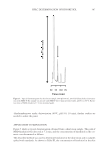PHYSICOCHEMICAL PROPERTIES OF DELIPIDIZED HAIR 361 sold under the trade names Styleze W and Ceraphyl 65, respectively. Styling treatments consisted of various molecular weights of PVP manufactured by Ashland, Inc. under the tradenames of PVP K-15 (Mw = 8,000), PVP K-30 (Mw = 60,000), PVP K-60 (Mw = 400,000), PVP K-90 (Mw = 1,300,000), and PVP K-120 (Mw = 3,000,000). RESULTS AND DISCUSSION We investigated the physicochemical properties of hair contributed by its free lipid com- ponents. By subjecting hair to a series of solvent extractions, we were able to effectively remove noncovalently bound lipids and, thus, make comparisons with virgin hair con- taining its normal lipidic components. Many of the techniques used in this study yielded results demonstrating that noncovalently bound lipids infl uence various properties of hair. INVESTIGATION OF HAIR BIOPHYSICS/BIOCHEMISTRY The chemical compositional changes including lipid loss, protein conformation, and water binding capacity were monitored by FTIR spectroscopic imaging (6). In our ex- amination of cross sections of hair, we generate images that qualitatively show the dis- tribution for selective wavelength regions of the infrared spectrum that correspond to a biophysical feature of hair morphology. For example, by monitoring the lipid band at 2850 cm-1 (methylene asymmetric stretching), we can generate an image of the cross section of hair that shows the distribution of lipid in the cuticle, cortex, and medulla. In virgin hair, we generally see most of the lipids are concentrated in the medulla. When we extract hair with n-hexane we fi nd that surface lipids are removed, but lipids within the internal structure of hair remain. It is not until hair is rigorously extracted with chloroform/methanol (70:30) that all of the lipids are removed. FTIR spectro- scopic images of the lipid distribution in hair cross sections are shown in Fig. 3. As depicted by the scale, dark colors in the image (blue) indicate lower concentrations of lipid while brighter colors (yellow/orange/brown) are due to higher concentrations of lipid. In virgin hair, especially of Asian origin, we note that the greatest concentration of lipids tends to be in the medulla region of hair. This was discussed in greater detail in a previous publication (6). Examining Fig. 3, we can clearly see that delipidized hair contains much lower concentrations of lipid across the entire fi ber cross section than virgin hair. HAIR SURFACE ANALYSIS To probe the surface properties of hair we used dynamic contact angle analysis, mechani- cal combing measurements, and AFM. Changes in the molecular properties of materials lead to changes in their macroscale properties. For example, the wetting properties of a surface can change due to chemical modifi cation. We measured the DCA using single fi ber (Wilhelmy) methodology. In this technique, a hair fi ber is anchored to a microbal- ance then immersed in H2O. On the basis of the wettability of the fi ber in water, contact angle determinations can be made using the following equation:
JOURNAL OF COSMETIC SCIENCE 362 F•g = γ•PR•cosθ (1) In this case, F is the interaction force between hair fi ber and water (called wetting force), g is the gravitational constant, γ is the surface tension of water, PR is the wetted perim- eter of solid, and θ is the contact angle between hair and water. For hair fi bers, PR equals πD (D is the hair fi ber diameter). On the basis of our studies of the two hair types, we observed a decrease in DCA from 95.72 ± 6.21° for virgin hair to 79.60 ± 7.12° for deli- pidized hair. For comparison with previously obtained measurements in the literature, values of 103 ± 4° and 98 ± 2° were obtained for dry and soaked virgin caucasian hair, respectively (9). Typically, chemical damage to the hair surface (e.g., from bleaching, permanent waving, etc.) results in contact angle measurements ranging from 70 to 80°. Combing measurements show increases in both dry and wet combing forces of delipidized hair. Such a result is not surprising because adding oils to hair facilitates combing. Thus, the contrary should be true when lipids are removed from hair. Table I contains wet combing data that were obtained by integrating the entire combing curve. Clearly, a distinction may be made between virgin (0.061 g cm) and delipidized (0.325 g cm) hair, with the latter being more than fi ve times more diffi cult to comb. The increase in comb- ing of delipidized wet fi bers refl ects the greater infl uence of capillary forces in this hair type, presumably due to its more hydrophilic surface. Likewise, we found appreciable differences between both hair types when examining dry combing curves. Typically, dry combing curves begin with very low combing forces (root section and middle of the tress) followed by a large peak corresponding to the bottom of the tress where the tips of the fi bers become entangled. To differentiate various effects in Figure 3. FTIR spectroscopic imaging of hair cross sections obtained by monitoring the lipid peak (2850 cm-1).
Purchased for the exclusive use of nofirst nolast (unknown) From: SCC Media Library & Resource Center (library.scconline.org)





















































































